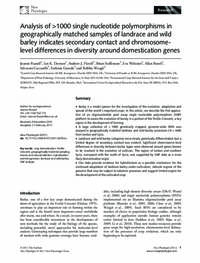Analysis Of > 1000 Single Nucleotide Polymorphisms In Geographically Matched Samples Of Landrace And Wild Barley Indicates Secondary Contact And Chromosome-Level Differences In Diversity Around Domestication Genes

Authors:
Barley is a model species for the investigation of the evolution, adaptation and spread of the world's important crops. In this article, we describe the first application of an oligonucleotide pool assay single nucleotide polymorphism (SNP) platform to assess the evolution of barley in a portion of the Fertile Crescent, a key region in the development of farming. A large collection of > 1000 genetically mapped, genome-wide SNPs was assayed in geographically matched landrace and wild barley accessions (N = 448) from Jordan and Syria. Landrace and wild barley categories were clearly genetically differentiated, but a limited degree of secondary contact was evident. Significant chromosome-level differences in diversity between barley types were observed around genes known to be involved in the evolution of cultivars. The region of Jordan and southern Syria, compared with the north of Syria, was supported by SNP data as a more likely domestication origin. Our data provide evidence for hybridization as a possible mechanism for the continued adaptation of landrace barley under cultivation, indicate regions of the genome that may be subject to selection processes and suggest limited origins for the development of the cultivated crop.
